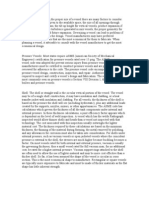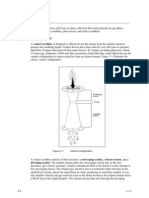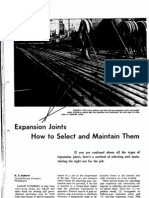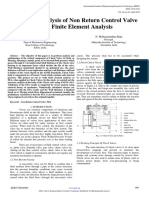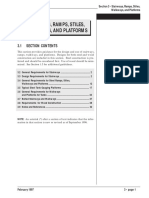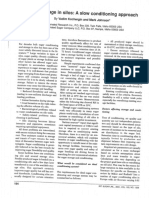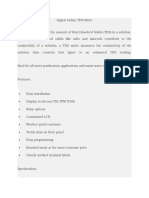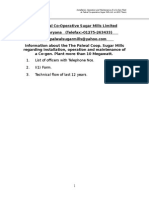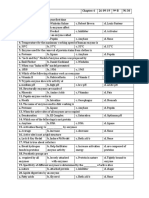Screens
Screens
Uploaded by
Arun GuptaCopyright:
Available Formats
Screens
Screens
Uploaded by
Arun GuptaOriginal Description:
Copyright
Available Formats
Share this document
Did you find this document useful?
Is this content inappropriate?
Copyright:
Available Formats
Screens
Screens
Uploaded by
Arun GuptaCopyright:
Available Formats
CE 523 NOTES ON SCREENS
Wastewaters may contain coarse suspended and floating matter that may damage or
interfere with the operation of pumps and other equipment. This material is usually
removed by simple screening devices, which represents the most economical form of
treatment
In water supply systems, screens are usually located at intakes from rivers, lakes or open
storage reservoirs, where they serve to prevent the entry of logs and sticks or even fish
and animals (see introductory presentation). In sewerage systems, screens are sometimes
provided at the inlet to sewage pumping stations where rags, paper and other coarse
materials could cause damage by fouling pump impellers. lso, screens are placed on
sewer overflow structures where it is desirable to prevent coarse materials from fouling
the receiving environment. !creens are usually installed at the inlets to wastewater
treatment plants to remove materials that may otherwise become entangled in pumps,
scrapers and aeration devices, or may foul weirs and channels.
Classification of screens
!creens may be classified variously according to" their clear opening si#e (as coarse,
medium or fine)$ their configuration (racks, bar screens or mesh screens)$ the method
used to clean the entrapped material from the screen surface (manually%raked or
mechanically%raked, or water%&et cleaned)$ and also according to whether the screen
surface is fi'ed or moving. (ombined screening and maceration devices are sometimes
used at wastewater treatment works.
Fixed screens
Racks and bar screens These are the simplest forms, and are widely used at inlets to
wastewater treatment plants, and on river intakes for water supplies.
Bar screens consist of parallel metal bars with )* to +* mm clear openings in coarse
screens, and ,* to )* mm clear openings in fine to medium screens. -ine screens are
usually preceded by coarse screens in order to prevent the risk of damage by large
ob&ects, or e'cessive head loss as screenings accumulate.
.ar screens may be satisfactorily cleaned by manual raking in small installations
(-igure,a%i). /arge installations, however, are generally provided with mechanical
devices for removing screenings at regular intervals (-igure ,a%ii). !uch devices may be
operated either by time clocks or by pressure%sensing probes, and are activated when the
head loss across the screen becomes e'cessive. large number of proprietary screens
with mechanical rakes is currently available. In most cases, manufacturers provide
design charts to facilitate selection of appropriate screen si#es.
Mesh screens These are used mainly in water supply and water treatment installations.
They have square openings ranging in si#e from , to )0 mm or greater, according to
design requirements. 1ost fine mesh screens are used in locations where relatively small
amounts of material are to be removed, and these usually are manually cleaned. !uch
1
screens, for e'ample, may follow bar screens on water intakes in order to prevent small
fish from being drawn into the intake.
Moving screens
Drum screen This is a continuous screening device consisting of a hollow drum, usually
) to 0 m in diameter, which rotates about its hori#ontal a'is (-igure ,b). 2ne end of the
drum is closed. Water enters the drum through the opposite end and passes out through
perforations or mesh openings in the drum3s periphery. s the drum rotates, screenings
caught on it are carried clear of the water surface and are deposited in a collecting trough.
Water &ets help to clean the entrapped material from the screen surface.
Disc screen This consists of a large rotating partly immersed metal disc, often set at an
angle of about 4* to the vertical. !olids caught on the face of the disc are carried to the
top where they are removed by revolving brushes.
Fine belt screens These are made of fle'ible woven wire mesh. lthough only rarely
used in the treatment of water and municipal sewage, they are commonly used in
industrial wastes treatment. The rotation of the screen is an aid to cleaning. !ome belt
screens are vibrated to increase efficiency and prevent clogging when screening out fine
material, such as spent grain from a distillery or fine organic wastes from a canning
factory.
Medium belt screens These are used for continuous operation to remove floating and
suspended debris from water supply intakes. They consist of sections of mesh attached to
frames which are hinged together and mounted on a chain belt (-igure ,a%ii).
Microstrainers These are a development of the drum screen in which the screening fabric
consists of woven stainless steel micromesh (-igure ,c). 1icromeshes, with apertures
ranging from ,0 to +5 mm, are used to remove very fine suspended matter from feed
water. They are usually *.6 to 4 m in diameter and rotate at a ma'imum peripheral speed
of *.0 m7s. 8ffective cleaning of microstrainers requires high%pressure water &ets using
good quality water. To control the growth of slime bacteria, which would rapidly clog the
micromesh, the drum surface can be bathed in ultraviolet light.
The principal application of microstraining is the pre%treatment of some types of water
supply, prior to using other treatment processes. In the case of some good%quality upland
waters, it may be all the treatment necessary for removing some types of algae and other
planktonic organisms. In wastewater treatment, microstrainers are also used at a tertiary
stage to further improve a good%quality secondary effluent by removing suspended solids
escaping from the final sedimentation tanks. In these applications, microstrainers fulfil a
function more usually associated with filters than with conventional screens.
/oading rates of 40* to ) 4** m
4
7m
)
.d have been claimed for microstrainers, but in any
particular application the design should be based on tests carried out on the water to be
treated. -or design purposes, conventional water analyses, such as those used for
suspended solids, provide inadequate information since the number, si#e and shape of
particles all affect the rate of removal by microstrainers .
Wedgewire screens !ee figure below and http"77www.wedgewire.com7 !ee also figure at end.
2
With sharp edges (almost no radius) and a
very smooth surface, the V shape profile wires
ensure that the solid particles make only 2
points contact with the screen surface..
articles do not get trapped in the slot
opening and do not have any pro!lem
sliding on the surface. "s a result,clogging
of the slot opening is none, the !linding
effect gets minimi#ed and the open area
availa!le remains constant
Wedgewire screens are superior for retaining media, filtering, and si#ing. $n comparison with wire mesh and
perforated metal, wedge wire continuous slot screens have more open area, have very precise openings,
are stronger and more dura!le, are virtually non%clogging and reduce media a!rasion. Wire mesh and
perforated metal may !e less e&pensive initially, !ut wedgewire screens offer easier installation and long%
term operating and cost !enefits. Wedge wire screens have ma&imum design fle&i!ility, can !e constructed
in a wide variety of shapes and si#es from a variety of corrosion resistant alloys such as type '(), '*+,
'*+,, '2*, and )*(- stainless steels, as well as nickel alloys such as .%2/+.
Underdrains of filters
and packed columns
In order to retain finer
material within large
process units, there is a
need for distributors or
no##les or screens.
8'amples of these are
shown in the figure at
the right.
Disposal of screenings
!creenings removed at water supply intakes usually comprise leaves, sticks and other
vegetable matter which are relatively inoffensive and may be returned to the river
downstream of the intake. Wastewater screenings are often heavily contaminated with
3
faecal matter and need to be carefully disposed of as quickly as possible 9 usually by
burial, incineration, or maceration and returned to the flow.
Design of screens
The main factors to be considered in screen design are" the strength and durability of the
screening medium$ the clear screen area$ ma'imum flow velocity through the screen
apertures so that screenings will not be dislodged$ minimum velocity in the approach
channel to prevent settlement of suspended matter on the channel floor, and the head loss
through the screen. In most cases mild steel is satisfactory for making screens but other
materials may need to be considered in abnormally corrosive environments. The strength
of the screen media should be sufficient to withstand impact of large floating ob&ects and
the forces that may be generated by mechanical cleaning devices.
:enerally, the velocity through screen apertures should not e'ceed *.+ to ,.* m7s,
depending upon the nature of the materials to be removed and their susceptibility to being
forced through the screen at higher flow velocity. To prevent deposition of sand and other
suspended matter in approach channels, a minimum flow velocity is required. This is
related to both the si#e and density of the suspended impurities and to the flow velocity in
the channel from which the water or wastewater was drawn. minimum velocity of
*.4 to *.5 m7s is usually sufficient to prevent e'cessive accumulation of settled materials
in approach channels.
Head loss through screens
The minimum head loss through clean screens can be estimated by considering the screen
to appro'imate an orifice or a short conduit, or even by applying a minor loss e'pression.
widely quoted minor loss equation, useful for estimating minimum head loss through
clean bar screens is" sin
)
)
4
5
g
V
b
w
h
a
=
ere h is the head loss across the screen (m)$ is the shape factor (; ).5 for square%edged
rectangular bars)$ w is the ma'imum bar width (mm)$ b is the minimum aperture width
(mm)$ Va is the velocity in the approach channel (m7s)$ g is acceleration due to gravity,
and is the angle of inclination of the bars to the hori#ontal (commonly 4*).
This e'pression is of use in determining the minimum hydraulic losses through screens at
the various rates of flow that occur, but is of no value in determining head loss once
material begins to accumulate on the screen surface. <esign should take into account the
ma'imum increase in head loss likely to occur under the critical condition of ma'imum
flow and minimum cleaning frequency. With mechanically%raked screens, this can be
readily accommodated by providing an automatic cleaning system. 1anually%raked
screens, however, should have liberal freeboard in the upstream channel to avoid the
danger of overtopping the channel at high flows.
Example on use of screens
Dirty water flows through a channel at 900 m
3
/h. A bar screen is to be used with 10 mm
openings, 16 mm bar width at an angle within the channel, which is 1 m deep and 60 cm
wide. The restriction to the design is that no more than a 15 cm increase in depth
4
upstream can be allowed. Available apertures will be reduced to 30% due to fouling in
the process. Suggest a suitable angle.
Solution
900 m
3
/h = 0.25 m
3
/s
For a minimum velocity of 0.5 m/s, maximum depth would be x in 0.25/0.6x = 0.5, i.e. x
= 5/6 m or 0.833 m For a 15 cm increase in head, downstream depth will be 0.68 m.
Assumption If h = 0.15 m for a screen in which apertures have been reduced to 30%,
then h for a clean screen will be 0.15 x
4*
,**
= 0.045 m.
Empirical formula:
sin
)
5 . )
)
4
5
g
V
b
w
h
a
=
, i.e.
sin
6 . = )
0 . *
,*
,+
5 . ) *50 . *
)
4
5
=
sin = 0.78 = 51.8
Another approach would be to increase w and decrease b, assuming a uniform deposit.
Because of the exponent larger than 1, the effect of this is more dramatic. This is
probably a less correct approach, as the dirt is more usually deposited as big blobs
obstructing parts of the whole width of the apertures, leaving the rest of the aperture
open.
Applications
Industries Served
0e%Watering .ollectors .hemical Water 1reatment
2low 0istri!ution 2ilter 3lements etro%.hemical Waste 1reatment
4nderdrains .ar!on 5etention 6ineral rocessing -ugar
$ntake -creens .atalyst 5etention .ement .orn 6illing
5esin 1raps 0istri!utors 2ood rocessing harmaceuticals
2ilter -upport .ores 5eactor -creens 7everage ulp 8 aper
9utlet 7askets 1rap 2ilters etroleum Water 8 $rrigation
.enter ipes :;: -trainers
.ackwash direction
Normal screening direction
5
http://www.hydrokuk.co.uk/scrnprod.htm
Screen Types
PPROFILE BAR SCREENS
1his construction is uni<ue to =endrick. 1he mechanically
interlocked design is perfect for applications that re<uire high
strength and a very flat surface. We !elieve it>s the strongest
construction availa!le on the market. "nd it is used heavily in
cylindrical applications. $t can !e manufactured in slot openings
as close as (.((?: and flatness to .(+(.
rofile 7ar screens are used in etrochemical, 2ish 0iversion,
ulp 8 aper, Waste Water, 2ood, and "rchitectural industries.
LOOPED WIRE SCREENS
,ooped Wire screens provide the perfect solution to vi!ratory
applications that re<uire high strength !oth laterally and
transversely.
Wires are looped around a supporting cross rod and
compressed to fit snugly. -lots can !e manufactured to (.((?:.
,ooped Wire is used in the 7rewing, Waste Water, 6ining and
"ggregate, and .hemical industries.
RESISTANCE WELDED SCREENS
"re produced !y wrapping a wire helically around support rods
to create a cylinder with continuous slot openings. 1he wires are
automatically resistance welded to each support rod producing
a very strong wedgewire cylinder with e&cellent !eam, !urst and
collapse strength. 5esistance welded cylinders produce screens
with slot openings to .(() and very large percentage of open
area. 1he screens are widely used in food and !everage
processing, water intakes, fish diversion, architectural, and
petrochemical applications.
6
You might also like
- KKR Annual Review 2007Document56 pagesKKR Annual Review 2007AsiaBuyouts100% (1)
- 1828 SzatmarosszeirasDocument190 pages1828 Szatmarosszeiraslaci1965No ratings yet
- BRCGS Food Safety Management System Implementation WorkbookDocument37 pagesBRCGS Food Safety Management System Implementation WorkbookRANDRIANIAINANo ratings yet
- Sea WaterDocument39 pagesSea WaterArun GuptaNo ratings yet
- Application Performance Management For Microservice Applications On Kubernetes The UltimateDocument24 pagesApplication Performance Management For Microservice Applications On Kubernetes The UltimateankitnayanNo ratings yet
- Types of Screens: Primary TreatmentDocument20 pagesTypes of Screens: Primary TreatmentMadhuri GuptaNo ratings yet
- RUH Umpen: Ruhrpumpen GMBHDocument40 pagesRUH Umpen: Ruhrpumpen GMBHjacobo nasimbaNo ratings yet
- Vessel Heads BottomDocument9 pagesVessel Heads BottomFahad RockingNo ratings yet
- Mechanics of Slow Draining of Large Cylindrical Tank Under GravityDocument11 pagesMechanics of Slow Draining of Large Cylindrical Tank Under GravityReliusman DachiNo ratings yet
- Appendix02 - The SI Metric System of Units and SPE Metric Standard PDFDocument38 pagesAppendix02 - The SI Metric System of Units and SPE Metric Standard PDFluisinho100% (1)
- Vent Guide Dec2016Document37 pagesVent Guide Dec2016Domin YuanNo ratings yet
- Drainage Tank Uniform Cross SectionDocument6 pagesDrainage Tank Uniform Cross SectionmlarakahanNo ratings yet
- Screens and ScreeningDocument5 pagesScreens and ScreeningCalcetinNo ratings yet
- Hopper Design Principles - Chemical EngineeringDocument13 pagesHopper Design Principles - Chemical EngineeringElton ViannaNo ratings yet
- Steel Plate Shear WallDocument43 pagesSteel Plate Shear WallMark Magadia IpaNo ratings yet
- Wear ProtectionDocument6 pagesWear ProtectionRafael CortezNo ratings yet
- Exact Solution Tank DrainageDocument8 pagesExact Solution Tank DrainageFelipe CastNo ratings yet
- Isolith 100: Ceramic Tile AdhesiveDocument2 pagesIsolith 100: Ceramic Tile AdhesiveContracting and Trading CompanyNo ratings yet
- Mixing ImpellersDocument4 pagesMixing ImpellersBalaNo ratings yet
- In Line MixingDocument4 pagesIn Line MixingKemas Ganesha MahendraNo ratings yet
- Venturi Scrubbers: Lesson 3Document14 pagesVenturi Scrubbers: Lesson 3AdhitomoWirawan100% (1)
- Impellers SelectionDocument0 pagesImpellers Selectionpeach5No ratings yet
- Column Internals: 1. Liquid DistributorDocument2 pagesColumn Internals: 1. Liquid Distributornaved ahmedNo ratings yet
- Drain Time of TankDocument6 pagesDrain Time of TankDhananjay KadamNo ratings yet
- WeirDocument2 pagesWeirnlnmurthy28No ratings yet
- Expansion Joints How To Select and Maintain ThemDocument6 pagesExpansion Joints How To Select and Maintain ThemSeungmin PaekNo ratings yet
- Eshtiaghi 2013Document18 pagesEshtiaghi 2013lukasz_wieczorek_pracaNo ratings yet
- Mixing VarietiesDocument64 pagesMixing VarietiesManojkumarNo ratings yet
- Iso 15136-1 7 - 9 - 11 - F - 4Document6 pagesIso 15136-1 7 - 9 - 11 - F - 4Scenic777No ratings yet
- Asme Sa-836 Specification For Forgings, Titaniumstabilized Carbon Steel, For Glass-Lined Piping and Pressure Vessel ServiceDocument5 pagesAsme Sa-836 Specification For Forgings, Titaniumstabilized Carbon Steel, For Glass-Lined Piping and Pressure Vessel Servicelucecita1902No ratings yet
- TT Oil Flooded Rotary Air CompressorDocument2 pagesTT Oil Flooded Rotary Air Compressorajo2402No ratings yet
- 06 Practical Design ApproachDocument10 pages06 Practical Design ApproachballisnothingNo ratings yet
- Handbook of Industrial Mixing-Science and PracticeDocument2 pagesHandbook of Industrial Mixing-Science and Practicekareem_opo0% (1)
- Gas Entrainment at A Propagating Slug Front: Ruben SchulkesDocument19 pagesGas Entrainment at A Propagating Slug Front: Ruben SchulkesAzizNo ratings yet
- Spring Design 101: Ace Wire Spring & Form Co., IncDocument15 pagesSpring Design 101: Ace Wire Spring & Form Co., IncmshameliNo ratings yet
- Exp JointDocument62 pagesExp JointDana GuerreroNo ratings yet
- Helical Strakes Are Aerodynamic Stabilizers Which Are Sometimes Used To Reduce TheDocument1 pageHelical Strakes Are Aerodynamic Stabilizers Which Are Sometimes Used To Reduce TheameybarveNo ratings yet
- Vibration-Free Rod-Baffle Design of TubeDocument5 pagesVibration-Free Rod-Baffle Design of Tubehwang2No ratings yet
- The Ow Pattern and Entropy Generation in An Axial Inlet Cyclone With Re Ux Cone and Gaps in The Vortex FinderDocument12 pagesThe Ow Pattern and Entropy Generation in An Axial Inlet Cyclone With Re Ux Cone and Gaps in The Vortex FinderdadNo ratings yet
- Melaku Tesfaye (Parafin Oil)Document55 pagesMelaku Tesfaye (Parafin Oil)aberNo ratings yet
- Clear Water From Industrial Waste Water: 80m3/hr, 80mDocument9 pagesClear Water From Industrial Waste Water: 80m3/hr, 80mSameera RanasingheNo ratings yet
- HDX HDXSSPDocument14 pagesHDX HDXSSPEmmanuel Ruiz100% (1)
- Pressure Relief ValvesDocument2 pagesPressure Relief ValvesdineshnexusNo ratings yet
- Extrusion Machine and LineDocument12 pagesExtrusion Machine and Linesamurai7_77No ratings yet
- Silverson Bottom Entry MixerDocument5 pagesSilverson Bottom Entry MixerDiego ArroyaveNo ratings yet
- Structural Analysis of Non Return Control Valve Using Finite Element AnalysisDocument5 pagesStructural Analysis of Non Return Control Valve Using Finite Element AnalysisAulia RahmanNo ratings yet
- Mixing Nozzles For Brewery TanksDocument8 pagesMixing Nozzles For Brewery TanksVikk SuriyaNo ratings yet
- Screen CalculationDocument6 pagesScreen CalculationRakesh RanjanNo ratings yet
- Storage Tanks Type of TanksDocument73 pagesStorage Tanks Type of TanksAfrad HossainNo ratings yet
- Aluminium ExtractionDocument5 pagesAluminium ExtractionSammyJayNo ratings yet
- Flow Through An OrificeDocument27 pagesFlow Through An Orificejochem_ligthartNo ratings yet
- 3.0 Stairways, Ramps, Stiles, Walkways, and Platforms: 3.1 Section ContentsDocument32 pages3.0 Stairways, Ramps, Stiles, Walkways, and Platforms: 3.1 Section ContentsBoy AlfredoNo ratings yet
- (Elearnica) - Hardfacing Technologies For Improvement of Wear Characteristics of Hot WorkDocument13 pages(Elearnica) - Hardfacing Technologies For Improvement of Wear Characteristics of Hot WorkelmiraNo ratings yet
- Venturi Scrubber Unit. Operator's Manual (Ecom) (Techne 02-2007) (41s) PDFDocument41 pagesVenturi Scrubber Unit. Operator's Manual (Ecom) (Techne 02-2007) (41s) PDFR_M_M_No ratings yet
- Hydraulic StandardsDocument2 pagesHydraulic StandardschatNo ratings yet
- Expansion Joint Technical Specification and Data Sheet1Document9 pagesExpansion Joint Technical Specification and Data Sheet1RAPHAEL suzartNo ratings yet
- HDPE Typical Pipe SizesDocument2 pagesHDPE Typical Pipe SizesSamet Belli100% (3)
- Installation, Operation and Maintenance Manual: Model BCSW-FRPDocument12 pagesInstallation, Operation and Maintenance Manual: Model BCSW-FRPcoolth2No ratings yet
- VJ CatalogueDocument196 pagesVJ CatalogueShane HancockNo ratings yet
- Rubberdamnew 140214103433 Phpapp02Document24 pagesRubberdamnew 140214103433 Phpapp02Mukhlish AkhatarNo ratings yet
- Wedge Wire Screen CatalogDocument27 pagesWedge Wire Screen Catalogjaime palenzuela rodriguezNo ratings yet
- Bar Screening Environmental EngineeringDocument11 pagesBar Screening Environmental EngineeringRajat Kushwaha100% (1)
- Screening and SkimmingDocument16 pagesScreening and SkimmingiploguNo ratings yet
- Sewage Disposal Works: Their Design and ConstructionFrom EverandSewage Disposal Works: Their Design and ConstructionNo ratings yet
- Guia Diseño RejasDocument10 pagesGuia Diseño RejasJose Alberto Muñoz FloresNo ratings yet
- 34 ST 25 35Document112 pages34 ST 25 35Arun GuptaNo ratings yet
- S. N Description QTY Mtrs Unit Price Rs Total Amount RsDocument1 pageS. N Description QTY Mtrs Unit Price Rs Total Amount RsArun GuptaNo ratings yet
- Weighing SystemDocument151 pagesWeighing SystemArun GuptaNo ratings yet
- Sugar Storage in SilosDocument5 pagesSugar Storage in SilosArun GuptaNo ratings yet
- JVK Filter Elements enDocument16 pagesJVK Filter Elements enArun GuptaNo ratings yet
- Dehumid Prod ListDocument9 pagesDehumid Prod ListArun GuptaNo ratings yet
- Digital Online TDS MeterDocument6 pagesDigital Online TDS MeterArun GuptaNo ratings yet
- RFP For Co-Gen at Palwal Sugar Mills LTDDocument32 pagesRFP For Co-Gen at Palwal Sugar Mills LTDArun GuptaNo ratings yet
- Static Mixer DataDocument6 pagesStatic Mixer DataArun GuptaNo ratings yet
- 652 PDFDocument12 pages652 PDFArun GuptaNo ratings yet
- Ship DesignDocument247 pagesShip DesignArun Gupta0% (1)
- Traffic Rules & Regulations For Two-Wheeler Riders: We Can Avoid Accidents by Following GuidelinesDocument1 pageTraffic Rules & Regulations For Two-Wheeler Riders: We Can Avoid Accidents by Following GuidelinesArun GuptaNo ratings yet
- Rpm/Rate Indicator With Alarms: SpecificationsDocument2 pagesRpm/Rate Indicator With Alarms: SpecificationsArun GuptaNo ratings yet
- RPM IndicatorDocument2 pagesRPM IndicatorArun GuptaNo ratings yet
- Mec411 Common AssignmentDocument21 pagesMec411 Common AssignmentAmreeNo ratings yet
- Components of A Successful SpeechDocument11 pagesComponents of A Successful SpeechzefanyongNo ratings yet
- Brealey9eIPPTCh06 Valuing BondsDocument41 pagesBrealey9eIPPTCh06 Valuing BondsTutku YapıcıNo ratings yet
- Closed-Loop Frequency Response - Control Systems Questions and AnswersDocument4 pagesClosed-Loop Frequency Response - Control Systems Questions and AnswersMarwan MohamedNo ratings yet
- Leaching of NaCl Using Water As SolventDocument10 pagesLeaching of NaCl Using Water As SolventKarynne Bernardine Gerona Siclot100% (1)
- Paper 2 (SPaG) - Revision BookletDocument16 pagesPaper 2 (SPaG) - Revision BookletHanaa ElmostaeenNo ratings yet
- Day01 Business Intelligence - ItiDocument16 pagesDay01 Business Intelligence - ItikirolosmagdyNo ratings yet
- Fb1200 Flow Computer en 454552Document26 pagesFb1200 Flow Computer en 454552ameer altiey أمير الطائيNo ratings yet
- St06032fu1 PDFDocument11 pagesSt06032fu1 PDFJamyang Palmu KatukNo ratings yet
- Chamod PaperDocument5 pagesChamod PaperThiranka AriyarathnaNo ratings yet
- Lesson 7 EnergyDocument16 pagesLesson 7 EnergyprathmfedNo ratings yet
- Example of Financial PlanDocument9 pagesExample of Financial PlanAlliah Mari Pelitro BairaNo ratings yet
- 92 C 78 BB 3 DCBBC 3 F 7Document7 pages92 C 78 BB 3 DCBBC 3 F 7Ahmad RamadhanNo ratings yet
- Magtrol: Customized Test System For ABS MotorsDocument1 pageMagtrol: Customized Test System For ABS MotorsGilbert MendozaNo ratings yet
- 5 3 3 2 + + - Where K Is An Integer To Be Found. (3) : 1 Without Using A Calculator, Show ThatDocument13 pages5 3 3 2 + + - Where K Is An Integer To Be Found. (3) : 1 Without Using A Calculator, Show ThatNirvaan PuriNo ratings yet
- Alcactive LiquidDocument18 pagesAlcactive LiquidArdyas Wisnu BaskoroNo ratings yet
- Security Requirements: - Introduce What Are - Define What AreDocument30 pagesSecurity Requirements: - Introduce What Are - Define What AreAssignments HelpersNo ratings yet
- XRP ExchangesDocument2 pagesXRP ExchangesGaindesec snNo ratings yet
- Diagnostic Test 1st TLEDocument2 pagesDiagnostic Test 1st TLEMilagross FabregasNo ratings yet
- AS2550 (1) AbstractDocument14 pagesAS2550 (1) AbstractkeepcalmandcarryonNo ratings yet
- 20200731-0100004846-SMOA-Mall-SERAPHINA INCDocument5 pages20200731-0100004846-SMOA-Mall-SERAPHINA INCEdjon AndalNo ratings yet
- Death of A SalesmanDocument123 pagesDeath of A SalesmanlwardNo ratings yet
- CS213 Data Structures and Algorithms PDFDocument3 pagesCS213 Data Structures and Algorithms PDFLinda TakuvaNo ratings yet
- Primary - Sekolah Cikal Surabaya - Enrollment Guide 2024-2025 3Document15 pagesPrimary - Sekolah Cikal Surabaya - Enrollment Guide 2024-2025 3Naura Athiyyah SativaNo ratings yet
- From The Start - Laufey Full ArrangementDocument16 pagesFrom The Start - Laufey Full ArrangementConor NiwinskiNo ratings yet
- Enzymes MCQsDocument2 pagesEnzymes MCQsNobody's PerfectNo ratings yet







